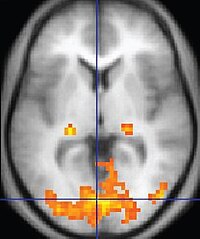
Photo from wikipedia
Background: Left ventricle (LV) segmentation using a cardiac magnetic resonance imaging (MRI) dataset is critical for evaluating global and regional cardiac functions and diagnosing cardiovascular diseases. LV clinical metrics such… Click to show full abstract
Background: Left ventricle (LV) segmentation using a cardiac magnetic resonance imaging (MRI) dataset is critical for evaluating global and regional cardiac functions and diagnosing cardiovascular diseases. LV clinical metrics such as LV volume, LV mass and ejection fraction (EF) are frequently extracted based on the LV segmentation from short-axis MRI images. Manual segmentation to assess such functions is tedious and time-consuming for medical experts to diagnose cardiac pathologies. Therefore, a fully automated LV segmentation technique is required to assist medical experts in working more efficiently. Method: This paper proposes a fully convolutional network (FCN) architecture for automatic LV segmentation from short-axis MRI images. Several experiments were conducted in the training phase to compare the performance of the network and the U-Net model with various hyper-parameters, including optimization algorithms, epochs, learning rate, and mini-batch size. In addition, a class weighting method was introduced to avoid having a high imbalance of pixels in the classes of image’s labels since the number of background pixels was significantly higher than the number of LV and myocardium pixels. Furthermore, effective image conversion with pixel normalization was applied to obtain exact features representing target organs (LV and myocardium). The segmentation models were trained and tested on a public dataset, namely the evaluation of myocardial infarction from the delayed-enhancement cardiac MRI (EMIDEC) dataset. Results: The dice metric, Jaccard index, sensitivity, and specificity were used to evaluate the network’s performance, with values of 0.93, 0.87, 0.98, and 0.94, respectively. Based on the experimental results, the proposed network outperforms the standard U-Net model and is an advanced fully automated method in terms of segmentation performance. Conclusion: This proposed method is applicable in clinical practice for doctors to diagnose cardiac diseases from short-axis MRI images.
Journal Title: Diagnostics
Year Published: 2022
Link to full text (if available)
Share on Social Media: Sign Up to like & get
recommendations!